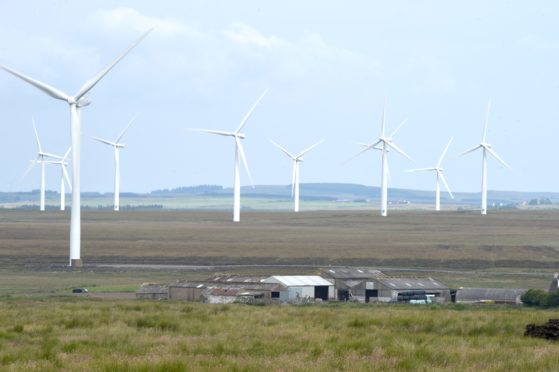Almost two-thirds of the major wind farms currently proposed for Scotland are in the north of the country, new figures have revealed.
And campaigners have alleged many of these developments will not even benefit the locals who will be affected by them most.
Information from the Scottish Government shows there are 27 wind farms currently in the pre-application, or scoping, phase, and a further 49 are at the next step of the process awaiting approval from Ministers.
Of these, a total of 26 are in the Highlands, and a further 18 are spread across Aberdeenshire, Moray, Argyll and Bute, Shetland and the Western Isles.
While permission for single turbines and smaller wind farms can be granted at a local authority level, anything that has a generating capacity of more than 50 megawatts of electricity must be decided by the Scottish Government’s Energy Consents Unit.
It also grants permission for the likes of large oil and gas pipelines and overhead electric lines.
The average onshore turbine has a capacity of between 2.5 and 3MW, which is enough to power 1,500 homes a year.
Generally, therefore, the major developments listed by the Scottish Government will have at least 15-20 turbines each.
The figures were obtained via freedom of information request by the Scotland Against Spin pressure group, which wants total reform of wind energy policies.
Chairman Graham Lang fears many of the prospective developments are not being designed to power homes in Scotland, but England and Wales.
He said: “In the Highlands and north-east Scotland, where so many developments are proposed, the projects follow the proximity of the National Grid wires.
“They can then gain a connection at least cost and export most of the electricity generated to centres of consumption, which are mostly far south of the border.
“Scotland’s pain is England’s gain.”
Highlands and Islands MSP Jamie Halcro Johnston said: “Communities across the Highlands and Islands are becoming increasingly concerned that the sheer volume of wind farm developments are leading to what are, effectively, industrialised landscapes.
“This concern is compounded by a sense that decisions are being made centrally by officials in Edinburgh rather than by local elected representatives who are accountable and who understand the impact these developments are having.
“There is a big difference between a landscape with some wind farms, and a wind farm-landscape.”
Morag Watson, the director of policy at Scottish Renewables, said onshore wind power is vital for a variety of reasons.
“Onshore wind already provides the bulk of Scotland’s renewable energy capacity, employing 5,400 people across our country,” she added.
“These are skilled jobs which bring prosperity and investment to communities where opportunities for this type of employment would otherwise not exist.
“The latest UK Government figures show onshore wind was more popular than ever in 2019 – figures which are reflected by research carried out in rural Scotland by Survation in 2018.
“Onshore wind is also supporting a thriving supply chain of businesses across Scotland and, of course, plays a large part in displacing 12 million tonnes of greenhouse gas emissions from our power sector each year.
“Our industry looks forward to working with communities and the Scottish Government to deliver more of those economic, environmental and social benefits as we move towards a net-zero energy future.”
Caroline Rance from Friends of the Earth Scotland said: “Tackling the climate emergency means we have to scale up renewable energy across Scotland.
“We need clean power to heat our homes and run our transport systems so that we can completely phase out the use of dirty, polluting fossil fuels.
“Onshore wind is currently the most cost effective form of generation but more work needs to be done by government to ensure that communities share in the benefits of such projects in their area, including creating local jobs, supporting local businesses and generating income for communities.”
“Renewable schemes must be carefully planned, in consultation with local communities and environmental experts to minimise impacts on wildlife and surrounding areas.”

